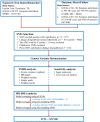Appraising the Causal Association between Systemic Iron Status and Heart Failure Risk: A Mendelian Randomisation Study
- PMID: 36014764
- PMCID: PMC9412602
- DOI: 10.3390/nu14163258
Appraising the Causal Association between Systemic Iron Status and Heart Failure Risk: A Mendelian Randomisation Study
Abstract
Although observational studies have shown that abnormal systemic iron status is associated with an increased risk of heart failure (HF), it remains unclear whether this relationship represents true causality. We aimed to explore the causal relationship between iron status and HF risk. Two-sample Mendelian randomisation (MR) was applied to obtain a causal estimate. Genetic summary statistical data for the associations (p < 5 × 10−8) between single nucleotide polymorphisms (SNPs) and four iron status parameters were obtained from the Genetics of Iron Status Consortium in genome-wide association studies involving 48,972 subjects. Statistical data on the association of SNPs with HF were extracted from the UK biobank consortium (including 1088 HF cases and 360,106 controls). The results were further tested using MR based on the Bayesian model averaging (MR-BMA) and multivariate MR (MVMR). Of the twelve SNPs considered to be valid instrumental variables, three SNPs (rs1800562, rs855791, and rs1799945) were associated with all four iron biomarkers. Genetically predicted iron status biomarkers were not causally associated with HF risk (all p > 0.05). Sensitivity analysis did not show evidence of potential heterogeneity and horizontal pleiotropy. Convincing evidence to support a causal relationship between iron status and HF risk was not found. The strong relationship between abnormal iron status and HF risk may be explained by an indirect mechanism.
Keywords: Mendelian randomisation; causal association; heart failure; iron status.
Conflict of interest statement
There is no conflict of interest among authors.
Figures




Similar articles
-
Causal correlations between inflammatory proteins and heart failure: A two-sample Mendelian randomization analysis.ESC Heart Fail. 2025 Apr;12(2):1374-1385. doi: 10.1002/ehf2.15151. Epub 2024 Nov 6. ESC Heart Fail. 2025. PMID: 39501838 Free PMC article.
-
Mendelian randomization study reveals a causal relationship between serum iron status and coronary heart disease and related cardiovascular diseases.Front Cardiovasc Med. 2023 Jun 13;10:1152201. doi: 10.3389/fcvm.2023.1152201. eCollection 2023. Front Cardiovasc Med. 2023. PMID: 37383700 Free PMC article.
-
Causal relationships between the gut microbiome, blood lipids, and heart failure: a Mendelian randomization analysis.Eur J Prev Cardiol. 2023 Sep 6;30(12):1274-1282. doi: 10.1093/eurjpc/zwad171. Eur J Prev Cardiol. 2023. PMID: 37195998
-
Causal inference on neuroimaging data with Mendelian randomisation.Neuroimage. 2022 Sep;258:119385. doi: 10.1016/j.neuroimage.2022.119385. Epub 2022 Jun 14. Neuroimage. 2022. PMID: 35714886 Free PMC article. Review.
-
Mendelian randomisation in cardiovascular research: an introduction for clinicians.Heart. 2017 Sep;103(18):1400-1407. doi: 10.1136/heartjnl-2016-310605. Epub 2017 Jun 8. Heart. 2017. PMID: 28596306 Free PMC article. Review.
Cited by
-
Causal effects between gut microbiota and IgA nephropathy: a bidirectional Mendelian randomization study.Front Cell Infect Microbiol. 2023 May 2;13:1171517. doi: 10.3389/fcimb.2023.1171517. eCollection 2023. Front Cell Infect Microbiol. 2023. PMID: 37201114 Free PMC article.
-
Walking pace is a protective factor for rheumatoid arthritis: a mendelian randomization study.Sci Rep. 2024 Oct 22;14(1):24886. doi: 10.1038/s41598-024-76666-6. Sci Rep. 2024. PMID: 39438628 Free PMC article.
-
Using Mendelian Randomization to Study the Role of Iron in Health and Disease.Int J Mol Sci. 2023 Aug 30;24(17):13458. doi: 10.3390/ijms241713458. Int J Mol Sci. 2023. PMID: 37686261 Free PMC article. Review.
-
Causal links between circulatory inflammatory cytokines and risk of digestive polyps: a Mendelian randomization analysis.Front Pharmacol. 2024 Oct 8;15:1405503. doi: 10.3389/fphar.2024.1405503. eCollection 2024. Front Pharmacol. 2024. PMID: 39439893 Free PMC article.
-
Kidney damage on fertility and pregnancy: A Mendelian randomization.PLoS One. 2023 Jul 21;18(7):e0288788. doi: 10.1371/journal.pone.0288788. eCollection 2023. PLoS One. 2023. PMID: 37478100 Free PMC article.
References
-
- Crespo-Leiro M.G., Metra M., Lund L.H., Milicic D., Costanzo M.R., Filippatos G., Gustafsson F., Tsui S., Barge-Caballero E., De Jonge N., et al. Advanced heart failure: A position statement of the Heart Failure Association of the European Society of Cardiology. Eur. J. Heart Fail. 2018;20:1505–1535. doi: 10.1002/ejhf.1236. - DOI - PubMed
-
- De Boer R.A., Nayor M., de Filippi C.R., Enserro D., Bhambhani V., Kizer J.R., Blaha M.J., Brouwers F.P., Cushman M., Lima J.A.C., et al. Association of Cardiovascular Biomarkers With Incident Heart Failure With Preserved and Reduced Ejection Fraction. JAMA Cardiol. 2018;3:215–224. doi: 10.1001/jamacardio.2017.4987. - DOI - PMC - PubMed
MeSH terms
Substances
Grants and funding
LinkOut - more resources
Full Text Sources
Medical
Research Materials
Miscellaneous

